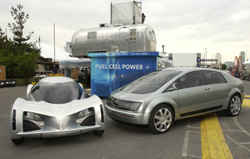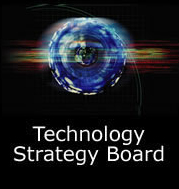|
|
|||||||||||||||||||||||||||||||||||||||||||||||||||
|
NEW for 2014 - The TOMCAT Ecostar BE4 (bare frame) DC50 city sports car concept featuring the Bluebird™ instant recharging system that is the enabling bridge between battery electric vehicles of today and the hydrogen fuel cell EVs of the future - Hydrogen Economy (HE) Ready. You wouldn't buy a TV that was not HD and 3D ready, so why buy a car that is not HE ready. Future proofed EV technology from Bluebird Marine System Ltd. Expressions of interest for collaborative consortium building are invited - aiming for a Horizon 2020 bid from 2015 >>.
It's
something to think about when giant corporations point out basic
environmental truths. Scott Foster, a General
Motors spokesperson on advanced technology vehicles, points
out that the 70 million cars on American roads could double to 140
million by 2025. These cars would also double the number of
miles traveled. So if we're dependent on hybrid technology
as our green savior, we'd need every hybrid to be 62 percent more
efficient than the best hybrid today just to stay where we are now
with fuel economy.
GM
says it's working on the problem
and says be patient. In
New York last week at the Tribeca
Film Festival GM unveiled a 75-kilowatt fuel cell powering an
outdoor screen ("the GM Drive-in"). GM's VP Larry Burns
said, "Fuel cells will be commercially viable when the cost
of the technology gets to a point that allows the vehicle to be
affordable and the auto companies profitable." That is
fairly obvious. The
problem is that skeptics like Joe Romm (author of The
Hype About Hydrogen) don't expect fuel-cell cars to arrive
until 2030. But Burns, whose company has been taking out
giant, two-page newspaper spreads touting the new energy, says
"We've been saying and still strongly believe that will
happen by 2010." If GM can field a fuel-cell car by 2010, it
would certainly silence the critics. "We realize we're
the most aggressive company talking about that kind of time
frame," Foster told me. "We're very excited about the
progress we've made on cost and power density, considering that
these cars are still handbuilt by Ph.Ds. We have 500 engineers
working on fuel cells, 200 of them near Rochester. So we think
2010 is a reasonable target for commercial viability." GM
expects that fuel-cell cars will carry hydrogen gas, which will be
reformed from gasoline or natural gas at the filling-station
level. The company is also working on solar and wind-generated
hydrogen, though it admits that's further in the future.
GM is also finally delivering its first hybrid vehicles, following Ford's splash with the hybrid Escape in New York last month. The company delivered the first V-8-powered hybrid Silverado pickup to Dade County, Florida May 3. Though the fuel-economy improvement is minor - only 10 to 12 percent - it would add up if it were applied to the hundreds of thousands of pickups GM sells annually. Unfortunately, Dade County's fleet only includes 50 trucks, and GM isn't planning to sell more than a few thousand in 2005. According to John Gaydash, a GM fleet spokesperson, the hybrid technology will add $2,500 to the price of the truck. It might take quite a while with that limited fuel improvement to recoup the investment. Of perhaps larger fuel savings is the new displacement-on-demand (DOD) technology, which shuts down banks of cylinders in Chevy Vortec V-8 engines (for an eight percent improvement) when the extra power isn't needed. GM plans to make that technology standard in such vehicles as the Trailblazer EXT, Envoy XL and XUV in 2005. Since every buyer will get DOD, it should have a real-world effect. Nelson, says: "As a lad, I admired most of the concept vehicles produced by General Motors at shows and in print. Way back in 1992 GM expressed an interest in my Joystick patent, but this was not pursued. I'm pleased to say they are continuing to produce great designs and to push forward the frontiers of automotive technology."
Overview Facts How fuel cells work Challenges Glossary Milestones Stationary Fuel Cells
THE PROPOSAL: ‘BLUEBIRD ECOSTAR UNIVERSAL EV SERVICE STATION (EVSS) PROTOTYPE’
RANGE ANXIETY - The blend of technology outlined above promises an innovative energy efficient vehicle and support infrastructure necessary that fulfills the aspirations of the Canadian authorities and member states of the European Union. CLEAN MOTORING - Electric vehicles incorporating a means of instant refuelling could make road transport clean and practical by eliminating the limited ranges of fixed battery EVs, which are perceived as less practical by the at present long parked-up recharge times.
BATTERY CARTRIDGE CHARGING - The battery cartridge charging stations shall comply with the EU legislation and international standards, such as IEC 61000. Alternatively, battery cartridges may be recharged via a charger of the onboard type in any country within the EU and US. For road cars, a smart-card Pay As You Drive (PAYD) system may be developed for forecourt style commercial battery cartridge exchanges.
ENERGY GENERATING-DISTRIBUTION UTILITIES
Email: Bluebird-Electric or phone UK:
+ 44 (0) 1323 831727 +44 (0) 7842 607865
Intelligent Battery Support System
The instant pit stop recharging system: Bluebird FE™ Formula E refueling.
Whatever
fuel powers our vehicle in the future, UK drivers will still need
competitive insurance - Try Hastings Direct and see how much you
could save.
|
|||||||||||||||||||||||||||||||||||||||||||||||||||
|
This website is copyright © 1991- 2014 Electrick Publications. All rights reserved. The bird logo and names Blueplanet Ecostar and Bluebird™ are trademarks. The Blueplanet vehicle configuration is registered ®. All other trademarks hereby acknowledged. Max Energy Limited is an educational charity working for world peace.
|




